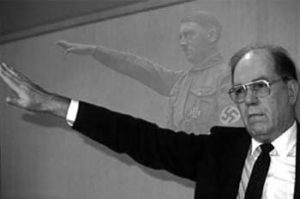
When Lyndon LaRouche’s disciples began setting up literature tables at American airports in the late 1970s, his conspiracy theories were already in full bloom, though not yet widely known. The same might be said about his claim to the title of “world’s greatest economist” — or the urgency of his followers about putting him in the White House. He was, in short, an unknown quantity to all but a very small segment of the American public. And that is perhaps the most difficult thing to imagine about him now.
For most of the past four decades his name has been a byword for “the paranoid style in American politics”; his ideology, a punchline in search of a joke involving the Queen of England. Both the reputation and the mockery were richly merited and are sure to continue posthumously.
But with the barrier between fringe and mainstream now so porous that Alex Jones is a widely recognized media figure — and the New York Times Book Review publishes a famous novelist’s celebration of an author preoccupied with the influence of lizards from another dimension on world culture — it’s worth recognizing that LaRouche’s career involved more than embodying the archetypal kook. In his prime LaRouche, with his bow-tie and Boston Brahmin accent, cultivated the demeanor of a distinguished professor. Those behind his literature tables might have been taken for graduate students — as, indeed, many of them had until recently been. The books and pamphlets on offer (mostly written by LaRouche himself) put forward an agenda that was pro-nuclear, anti-feminist, prone to a sly bits of antisemitic innuendo, and rather viciously homophobic. But what really stood out were the bumper stickers. “Feed Jane Fonda to the Whales” read one of the most popular. Another said, “More people were killed at Chappaquiddick than at Three Mile Island.” The sarcasm was quite effective at liberal-baiting (not then the focus group- perfected science it has since become) and it won LaRouche a hearing — perhaps especially from the constituency soon to be known as Reagan Democrats.
For thirty years LaRouche called himself a Marxist economist, in ways tending to imply that he was the only real one. And while he stopped doing so around 1978, he retained one guiding concept: the constantly expanding forces of production. That meant new technology and new energy sources (especially nuclear fusion) and a strengthened infrastructure grid. All of which would require crash development programs under a leader who was part Renaissance man, part technocrat. The list of candidates for that position had just one name on it.
Many of LaRouche’s policies, at least, held a certain appeal, even if voters were not exactly swept away by his presidential campaigns. In 1986, the Wall Street Journal published as credible “the estimate that LaRouche-related entities are spending $25 million to $30 million a year worldwide, the majority of it in the U.S.” Some of the funding came in by swindling senior citizens, and woe to the supporter who bought a LaRouche publication with a credit card. But the worst of the white collar criminal activity came after the movement had built up, if not a political base, then at least a clientele interested in its ideas. And one that reached beyond the U.S. Beginning in the late 1970s, the movement’s publications present one photograph after another of LaRouche meeting with business leaders, diplomats, and heads of state around the world, often while touting crash economic development programs.
LaRouche-movement events held in Washington, DC routinely drew staff from various embassies who, to judge by their questions and comments, clearly regarded him as a kind of philosopher-statesman-in- exile. After witnessing it a couple of times, I was relieved to hear a story about LaRouche’s meeting with Indira Gandhi told by some of his disillusioned ex-followers. The world’s greatest economist could scarcely resist discussing India’s affairs as viewed through his patented kaleidoscope of conspiracy. At a suitable moment Gandhi extricated herself, and was heard telling her assistants, “Don’t let that crazy man near me again!”
This is how one prefers to imagine someone like LaRouche will arrive on the political scene: recognizably florid, and quickly to be removed. But even he was once an unknown quantity.


Leave a Reply